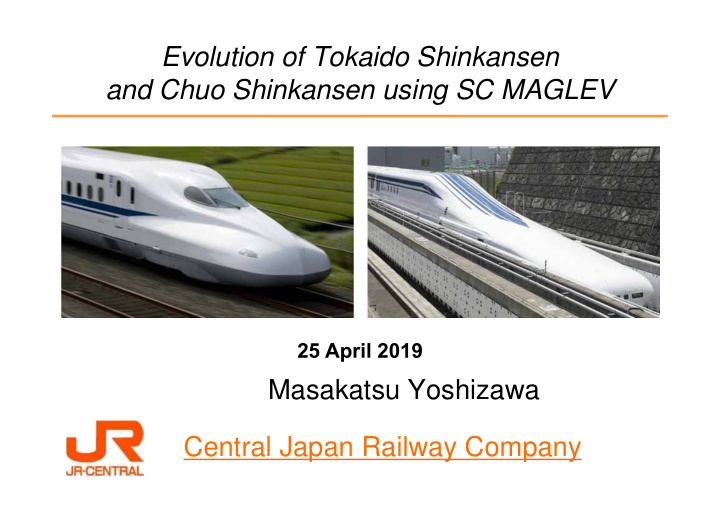



Evolution of Tokaido Shinkansen and Chuo Shinkansen using SC MAGLEV 25 April 2019 Masakatsu Yoshizawa Central Japan Railway Company
Tokaido Shinkansen – Japan’s main transportation artery
Key Performance Indicators of Tokaido Shinkansen As of FY2017
Trains depart every 3 minutes at peak
Started commercial operation on 1st October 1964
Series 0, manufactured for almost 20 years
Series 100, aimed to enhance passenger experience
Breakup and Privatisation of JNR Japanese National Railways (JNR) was geographically divided and privatised into 6 regional passenger companies
Shinkansen Network in Japan Lines Distance (Km) Operator Tohoku Shinkansen 674.9 JR East Joetsu Shinkansen 269.5 JR East JR East / JR West Hokuriku Shinkansen 345.4 2030 ~ Sapporo Tokaido Shinkansen 515.4 JR Central Sanyo Shinkansen 553.6 JR West Shin-Hakodate Hokuto Kyushu Shinkansen 256.8 JR Kyushu 2016 ~ Shin-Aomori Hokkaido Shinkansen 148.8 JR Hokkaido 2010 Hachinohe 2002 Morioka 1982 Niigata 1982 2015 Sendai Kanazawa Nagano 2022 ~ Takasaki Hakata Tsuruga 1997 1975 1972 Nagoya Takeo- Omiya Total Onsen 1964 Okayama 2011 2022 ~ Distance Shin-Osaka Tokyo Naga 2,765km saki Shin-Yatsushiro 2004 Kagoshima-Chuo
Series 300, attained 270km/h with a leap in technology Electric power Braking (Generating power) Powering (Consuming power)
Series 700, enhanced performance and riding comfort further
Evolution of Rolling Stock Technological Leap 1964-1999 220km/h 1985-2003 220km/h 1992-2012 270km/h 1999- 270km/h Period in operation and maximum commercial speed for Tokaido
JR Central Research Centre – “Komaki”
Vehicle Dynamic Simulator Rolling Stock Field Test Simulator Structure Loading Test Wind Tunnel Vibration Test
Evolution of Rolling Stock 1964-1999 220km/h 1985-2003 220km/h 1992-2012 270km/h 1999- 270km/h 2007/2013 - 270km/h → 285km/h Period in operation and maximum commercial speed for Tokaido
Series N700 – Rolling stock in the mainstream Optimised nose shape for speed ‐ up, superior riding comfort and enhanced environmental performance Model for wind tunnel tests Application of body inclining system Increased speed at curve Series N700 Control Device Increased acceleration Radius 2500 m Speed km/h Series 700 Position All braking by regenerative system Electric power Braking (Generating power) Powering (Consuming power)
N700S – To be introduced before Tokyo Olympics
JR Central – A Vertically Integrated Operator
General Control Centre
Training Simulator Training Track
Hamamatsu Workshop Re ‐ ballasting of track Restringing of contact wire Replacement of rail Dr Yellow
Chuo Shinkansen using SC MAGLEV
・ Outline of JR Central and Tokaido Shinkansen ・ Evolution of Tokaido Shinkansen focusing on Rolling Stock ・ How a vertically integrated railway operator works. ‐ Operation ‐ Training & Education ‐ Maintenance ‐ R&D ・ Chuo Shinkansen using SC Maglev
Recommend
More recommend